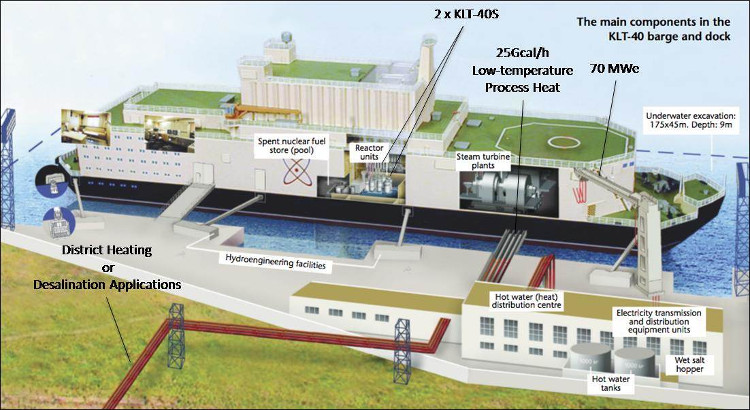Russia tested floating nuclear power plant
The Russian Federation has begun testing a floating nuclear power plant on a ship named "Lomonosov Academician".
According to Sputnik, the process of testing this unique power plant will last about a year.The floating nuclear power plant "Lomonosov Institute" has a displacement of 21.5 tons. The capacity of this plant can be up to 70 MW, enough to power a city with a population of more than 200,000 people, a seaport or offshore oil rigs.
In addition, the reactors can also be used to turn saltwater into fresh water, capable of producing 240,000 cubic meters of water a day to serve living and economic needs. The operating time of this floating nuclear power plant is about 40 years.
It is expected that after the tests, the factory "Lomonosov Institute" will be put into operation in the port city of Pevek of the Chukotka autonomous region in the Northeastern part of Russia. This area has many large companies specializing in oil, natural gas, gold and many other minerals.
Floating nuclear power plant is a mobile power plant with low capacity , in line with the latest electricity production trend, producing electricity in areas with immediate electricity demand.

Model of Russia's famous nuclear power plant.(Source: VNA).
However, this plant is not a self-propelled ship, it must be towed to a specified location in coastal areas. Once stabilized, floating nuclear power plants are connected to the coastal infrastructure to provide electricity and heat to residential areas. A floating nuclear power plant has a maximum capacity of more than 70MW. The plant is equipped with two KLT-40S reactors with 150MW / furnace heat generation capacity.
In December 2016, the Russian National Atomic Energy Group will begin loading nuclear fuel on Akademik Lomonosov's power unit. The power unit is expected to be ready for shipping in October 2017. The factory is expected to go into operation in November 2019.
The potential of the project has attracted the attention of many countries. China and Indonesia have expressed special interest in designing the floating power unit. On July 29, 2014, Rusatom Overseas Company of Russia and China New Energy Company CNNC signed a Letter of Intent on cooperation in the development of floating nuclear power plants.
Then, on September 10, 2015, in Jakarta, Indonesia's National Atomic Energy Agency (BATAN) signed a Memorandum of Understanding on the construction of high-capacity nuclear power plants and nuclear power plants. floating in Indonesia.
Floating nuclear power plants possess many outstanding features. A floating nuclear power plant is an automatic power production project ; The whole plant is built on the shipyard as a ship does not self-propelled and is towed to the sea or into the river to the location of use. Customers are provided with complete and tested electrical production facilities ready to operate, including complete housing and infrastructure, including accommodation for operators and security personnel. factory maintenance.
The factory's mobility allows it to be taken from one point to another as needed. Therefore, floating nuclear power plants are very suitable for operating in remote areas along the coast or along the river, away from the central power supply system. Some breakthrough solutions on safety and disaster prevention have been included in the design. The power plant was originally designed with "enhanced strength" to withstand maximum tsunami disasters, collide with boats or other offshore facilities.
- China - Russia builds a floating nuclear power plant
- The first floating nuclear power plant will operate in 2016
- Russia's floating nuclear power plant is ready to conquer the Arctic
- Successfully commissioned the world's first floating nuclear power plant
- Russia built the first floating nuclear power plant
- Russia built the world's first floating nuclear power plant
- Russia is committed to building safe nuclear power for Vietnam
- Nuclear power plant floating on water
- Vietnam's first nuclear power plant will be built by Russia
- Japan 'rescues' Russia's radioactive treatment plant
- He built the first new generation nuclear power plant
- Russia will deliver the most modern nuclear technology to Vietnam
 Norway built the world's tallest wooden tower
Norway built the world's tallest wooden tower Kremlin
Kremlin Ashurbanipal: The oldest royal library in the world
Ashurbanipal: The oldest royal library in the world Decoding the thousand-year construction of Qin Shihuang shocked the world
Decoding the thousand-year construction of Qin Shihuang shocked the world